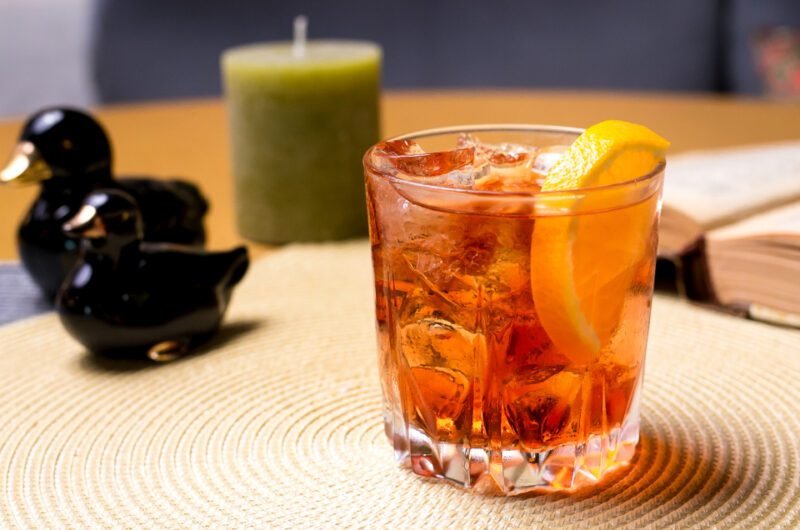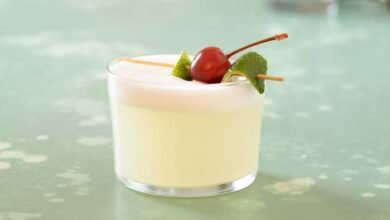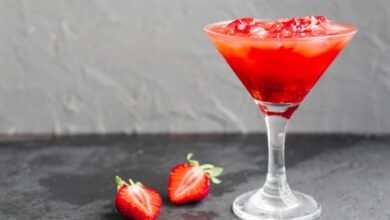Ooh, La, La Orange: Cozy Up with a French Negroni Hot Toddy

The Negroni, a celebrated classic Italian aperitivo cocktail, is a bitter-sweet symphony known for its ruby-red allure. Yet, in the world of mixology, cross-cultural creativity often leads to exciting variations. This is where the French version of Negroni emerged, French Negroni, an adaptation of the traditional recipe that replaces gin with Cognac, infusing the drink with warm complexity and a touch of elegance.
Contents
- French Negroni
- Why You’ll Love This French-Inspired Flavor?
- A Mellow and Nuanced Flavor Profile
- French Negroni vs. Classic Negroni
- Recommend Specific Brands of Cognac
- Let’s Craft Your Negroni
- Serving Glassware
- Variations & Customizations
- Ideal Serving Temperature:
- Expert Tips
- Frequently Asked Questions (FAQs)
- What is the French version of a Negroni?
- What does a French Negroni taste like?
- What is the difference between a classic Negroni and a French Negroni?
- Can I use any type of brandy for a French Negroni?
- What garnish is best for a French Negroni?
- Is the French Negroni sweeter or drier than the classic version?
- Can I make a batch of French Negronis in advance?
- What type of glass should I use for a French Negroni?
- French Negroni
French Negroni
The Negroni cocktail is renowned for its classic, yet simple recipe, resulting in a sophisticated drink with a unique flavor profile that balances bitter and sweet. Traditionally, Negronis are garnished with an orange twist, adding a pop of color to the jewel tones of the gin, vermouth, and Campari. However, it offers a tasty twist on this favorite, replacing the gin with Cognac. That minute variation lets the taste be rich and warm underneath, which gives more complexity than ever before but still preserves the classic balanced bitterness and sweetness of a Negroni.
Why You’ll Love This French-Inspired Flavor?
The French-inspired flavor of this variation is sure to captivate your palate with its unique pastel purple hue. Typically served in an iridescent rocks glass, the simple French Negroni recipe offers several compelling reasons to fall in love with this cocktail:
- Made with 3 Basic Ingredients (4 if You Add a Fancy Garnish): No obscure liqueurs or fussy muddling required.
- Quick & Easy: Just measure, pour over ice, stir, and strain. The whole process takes less than a minute.
- More Floral & Beautiful: Compared to its crimson cousin, this drink boasts a beautiful crimson color and a slightly bitter, yet bold flavor with a big personality. Plus, it’s bonus Instagram-worthy!
READ: Aperol Negroni
A Mellow and Nuanced Flavor Profile
The French Negroni ingredients offer a mellower, more nuanced experience than its Italian counterpart. The Cognac softens the gin’s juniper-forward punch, resulting in a smoother, richer flavor profile. Campari that is recognized for its bitterness is toned down by vermouth’s innate sweetness and the mixture is made more interesting with the addition of various ingredients in Cognac.
The overall effect is a cocktail that’s both sophisticated and approachable. The warmth from Cognac makes it ideal for colder months, whereas the bitter taste from Campari guarantees it remains cool during hot spells as well.
French Negroni vs. Classic Negroni
| Feature | Classic Negroni | French Negroni |
| Base Spirit | Gin | Cognac |
| Flavor Profile | Juniper-forward, bitter, herbal, slightly sweet | Mellow, complex, warm spice, dried fruit, subtle sweetness |
| Aroma | Juniper, citrus, spice | Dried fruit, vanilla, oak, spice |
| Mouthfeel | Crisp, clean, slightly oily | Smooth, round, velvety |
| Best For | Fans of bold, bitter cocktails, warm weather | Those who prefer a mellower drink, cooler weather |
| Additional Notes | More traditional, assertive flavor; wider range of gin choices can drastically alter the drink | Softer, more nuanced; Cognac choice impacts complexity and flavor depth |
Recommend Specific Brands of Cognac
VS or VSOP:
- Rémy Martin VSOP: This cocktail offers floral and fruity flavors, along with delicate sweetness and a hint of spiciness from the oak-aged rum.
- Hennessy VS: This is an adaptable Cognac that combines fruits, spices as well as some taste of wood to deliver a great all-rounder cocktail.
- Courvoisier VSOP: The Courvoisier VSOP brand speaks volumes with its rich, intricate scents of apricot, vanilla and oak; it thus makes the classic Negroni exceptional.
XO (for a more indulgent experience):
- Rémy Martin XO: It is an expensive brandy with deep notes of plum, orange rind and cinnamon. As such, it gives a rich flavor profile.
- Hennessy XO: Hennessy XO has an intense aroma consisting of candied fruit, spices and chocolate, making it one of the most outstanding spirits.
- Martell XO: Martell XO’s creamy texture and flavors such as rancio or walnut are distinctive features that can make any drinker realize how much better their regular negronis could be.
Let’s Craft Your Negroni

- Put all ingredients in a mixing beaker and fill it up with ice. Keep stirring until they are fully chilled.
- Fill a big cocktail glass that is either cube or sphere shaped with fresh ice and strain the beaker’s contents into it.
- Serve garnished with orange peel. Tip: Best enjoyed on a sunny patio in good company.
Serving Glassware
A French Negroni is typically served in a rocks glass or an Old Fashioned glass. These short, sturdy tumblers leave plenty of room for a large ice cube or sphere — essential for chilling and slowly diluting this potent drink.

For an added touch of elegance, some may opt for a Nick & Nora glass — a stemmed glass with a smaller bowl that concentrates aromas while providing an easy grip.
READ: Smoky Negroni
Variations & Customizations
Experimentation is possible with the French Campari as with many classic cocktails. Some popular ones include:
- Royal Negroni: A cognac mixture of Armagnac (another French brandy) adds complexity.
- L’Orange Negroni: A bit of orange liqueur such as Grand Marnier or Cointreau gives it a refreshing citrus touch.
- Pomme Negroni: A little apple brandy (Calvados) adds some fruity taste to it.
- Aged Negroni: Mix your cocktail in advance and allow it to sit in a barrel for some weeks to reduce flavors and increase complexity.
Also, the choice of Cognac plays a very important role. Commonly used are VS or VSOP, while older expressions like XO have more pronounced and deeper tastes.
Ideal Serving Temperature:
It is typically served chilled, but not ice-cold. The temperature to aim for should be around 45°F and 55°F (7°C and 13°C) so that the Cognac’s numerous flavors become pronounced.
When using large ice cubes or a round ball, the drink will gradually mix with water as the ice dissolves, and thus one can drink it slowly without it becoming too diluted.
Expert Tips
- Chill the mixing glass and ingredients to cool them down before adding the ice. This prevents the ice from melting too quickly.
- Add ice to the mixing glass last to prevent over-dilution of the drink.
- Use fresh, large ice cubes when serving, as this prevents premature dilution. An ice-filled rocks glass is the perfect choice for this recipe.
- Don’t over-stir. Start with 20–30 seconds of stirring, taste the drink, and if you want it a little softer, give it another 20 seconds or so. Total stirring time for most stirred drinks should be no more than about 50 seconds to avoid an overly diluted cocktail.
- If wanting to add a lovely garnish to your Negroni cocktail, an orange twist or peel makes a great addition.
- Take note of the popular Negroni Sbagliato, which adds a touch of soda water for a French twist on this classic drink.
READ: Chocolate Negroni
Conclusion
In conclusion, it offers a delightful twist on the classic cocktail. With Cognac replacing gin, it delivers a smoother, more nuanced experience with a touch of warmth. So, raise a glass to this cross-cultural creation and savor the symphony of flavors.
Frequently Asked Questions (FAQs)
What is the French version of a Negroni?
The version is called the French Negroni or Negroni Frenchie. It’s a variation of the classic Italian cocktail, but instead of using gin as the base spirit, it substitutes Cognac or another French brandy.
What does a French Negroni taste like?
It has a richer, more robust flavor compared to the classic Negroni due to the substitution of Cognac for gin. The brandy adds warmth, depth, and a subtle oakiness that complements the bitterness from the Campari and the sweetness from the sweet vermouth.
What is the difference between a classic Negroni and a French Negroni?
The main difference is that the French Negroni substitutes the traditional gin for a French brandy or Cognac, giving it a richer, warmer flavor profile.
Can I use any type of brandy for a French Negroni?
Experiment with different brandies, but use a high-quality French Cognac or VSOP brandy to experience the most authentic French Negroni.
What garnish is best for a French Negroni?
A classic orange twist or peel is a popular garnish choice, as the citrus complements the bitter and sweet flavors well. You could also try a lemon twist for a slightly different touch.
Is the French Negroni sweeter or drier than the classic version?
It tends to be slightly drier and less sweet than the classic gin-based Negroni due to the brandy substitution.
Can I make a batch of French Negronis in advance?
While you can batch the ingredients, it’s best to build each one individually just before serving to ensure proper dilution and balance.
What type of glass should I use for a French Negroni?
A rocks glass or stemmed cocktail glass works well for serving, allowing room for the large ice cube(s) to prevent over-dilution.
French Negroni
Course: CocktailsCuisine: French1
cocktail5
minutes150
kcal5
minutesRaise your glass to the French Negroni, a sophisticated and herbaceous twist on a beloved classic! Cheers!
Ingredients
2 oz. — Cognac
1.25 oz. — Campari
1.25 oz. — Sweet Vermouth
Directions
- Put all ingredients in a mixing beaker and fill it up with ice. Keep stirring until they are fully chilled.
- Fill a big cocktail glass that is either cube or sphere shaped with fresh ice and strain the beaker’s contents into it.
- Serve garnished with orange peel.
Notes
- Tip: Best enjoyed on a sunny patio in good company.
- It is typically served in a rocks glass or an Old Fashioned glass. For an added touch of elegance, some may opt for a Nick & Nora glass — a stemmed glass with a smaller bowl that concentrates aromas while providing an easy grip.






